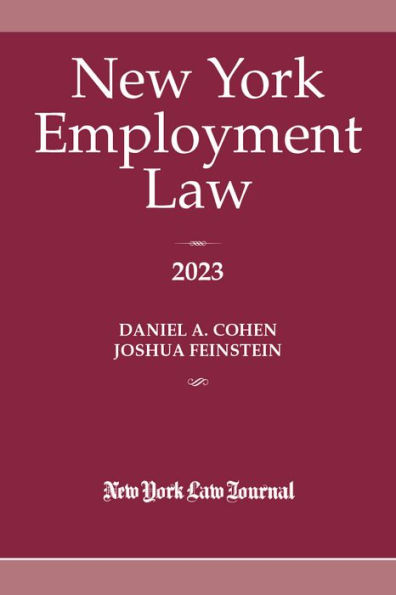New York Employment Law, by Daniel A. Cohen (Walden Macht & Haran LLP) and Joshua Feinstein (Hodgson Russ LLP), provides a fresh, and practical overview of relevant statutes and governing case law, explaining the interplay between state, local, and federal requirements. It identifies and follows path-breaking developments presently shaping this area of law. Among other critical topics, it addresses the employment contract; common law duties of loyalty; restrictive covenants; wage and hour laws and ordinances, including minimum wage and overtime requirements; laws against discrimination based on characteristics such as race, sex, sexual orientation, disability, age, and religion; employee leave requirements; whistleblower laws; torts in the workplace, including employer liability to third parties and workers’ compensation; protected speech and privacy; reductions in force; and unemployment insurance.
- Organized as a one-volume desk reference, New York Employment Law:
- Tracks the body of law you need to follow year to year.
- Narrows the focus before more costly research is employed by your associates.
- Provides practical suggestions and expert commentary.
- Views your matter through the eyes of respected colleagues and adversaries.
- Examines steps employers can take to avoid litigation.
- Identifies workplace policies that minimize liability.
New York Employment Law:
- Updates, briefs and informs employment attorneys, business litigators, General Counsel
- Advises human resource professionals as they interact with their legal departments.
- Informs and equips general practitioners without an extensive law library.
New York Employment Law analyzes in detail key provisions of New York employment statutes, including the New York Labor Law, the New York State Human Rights Law, the New York False Claims Act, the New York Worker Adjustment Retraining Notification Act, and the New York Unemployment Insurance Law. In addition, this book includes an extensive discussion of local law requirements, including the significant body of case law addressing the unique requirements of the New York City Human Rights Law.
This resource further highlights critical differences between New York law and major federal statutes, including Title VII of the Civil Rights Act of 1964 (as amended), the American with Disability Act, the Age Discrimination in Employment Act, the Fair Labor Standards Act, the Family and Medical Leave Act, and First Amendment case law.
New York Employment Law, by Daniel A. Cohen (Walden Macht & Haran LLP) and Joshua Feinstein (Hodgson Russ LLP), provides a fresh, and practical overview of relevant statutes and governing case law, explaining the interplay between state, local, and federal requirements. It identifies and follows path-breaking developments presently shaping this area of law. Among other critical topics, it addresses the employment contract; common law duties of loyalty; restrictive covenants; wage and hour laws and ordinances, including minimum wage and overtime requirements; laws against discrimination based on characteristics such as race, sex, sexual orientation, disability, age, and religion; employee leave requirements; whistleblower laws; torts in the workplace, including employer liability to third parties and workers’ compensation; protected speech and privacy; reductions in force; and unemployment insurance.
- Organized as a one-volume desk reference, New York Employment Law:
- Tracks the body of law you need to follow year to year.
- Narrows the focus before more costly research is employed by your associates.
- Provides practical suggestions and expert commentary.
- Views your matter through the eyes of respected colleagues and adversaries.
- Examines steps employers can take to avoid litigation.
- Identifies workplace policies that minimize liability.
New York Employment Law:
- Updates, briefs and informs employment attorneys, business litigators, General Counsel
- Advises human resource professionals as they interact with their legal departments.
- Informs and equips general practitioners without an extensive law library.
New York Employment Law analyzes in detail key provisions of New York employment statutes, including the New York Labor Law, the New York State Human Rights Law, the New York False Claims Act, the New York Worker Adjustment Retraining Notification Act, and the New York Unemployment Insurance Law. In addition, this book includes an extensive discussion of local law requirements, including the significant body of case law addressing the unique requirements of the New York City Human Rights Law.
This resource further highlights critical differences between New York law and major federal statutes, including Title VII of the Civil Rights Act of 1964 (as amended), the American with Disability Act, the Age Discrimination in Employment Act, the Fair Labor Standards Act, the Family and Medical Leave Act, and First Amendment case law.

New York Employment Law 2023
644
New York Employment Law 2023
644
Product Details
| ISBN-13: | 9781588526335 |
|---|---|
| Publisher: | ALM Media Properties, LLC |
| Publication date: | 06/28/2022 |
| Sold by: | Barnes & Noble |
| Format: | eBook |
| Pages: | 644 |
| File size: | 1 MB |
